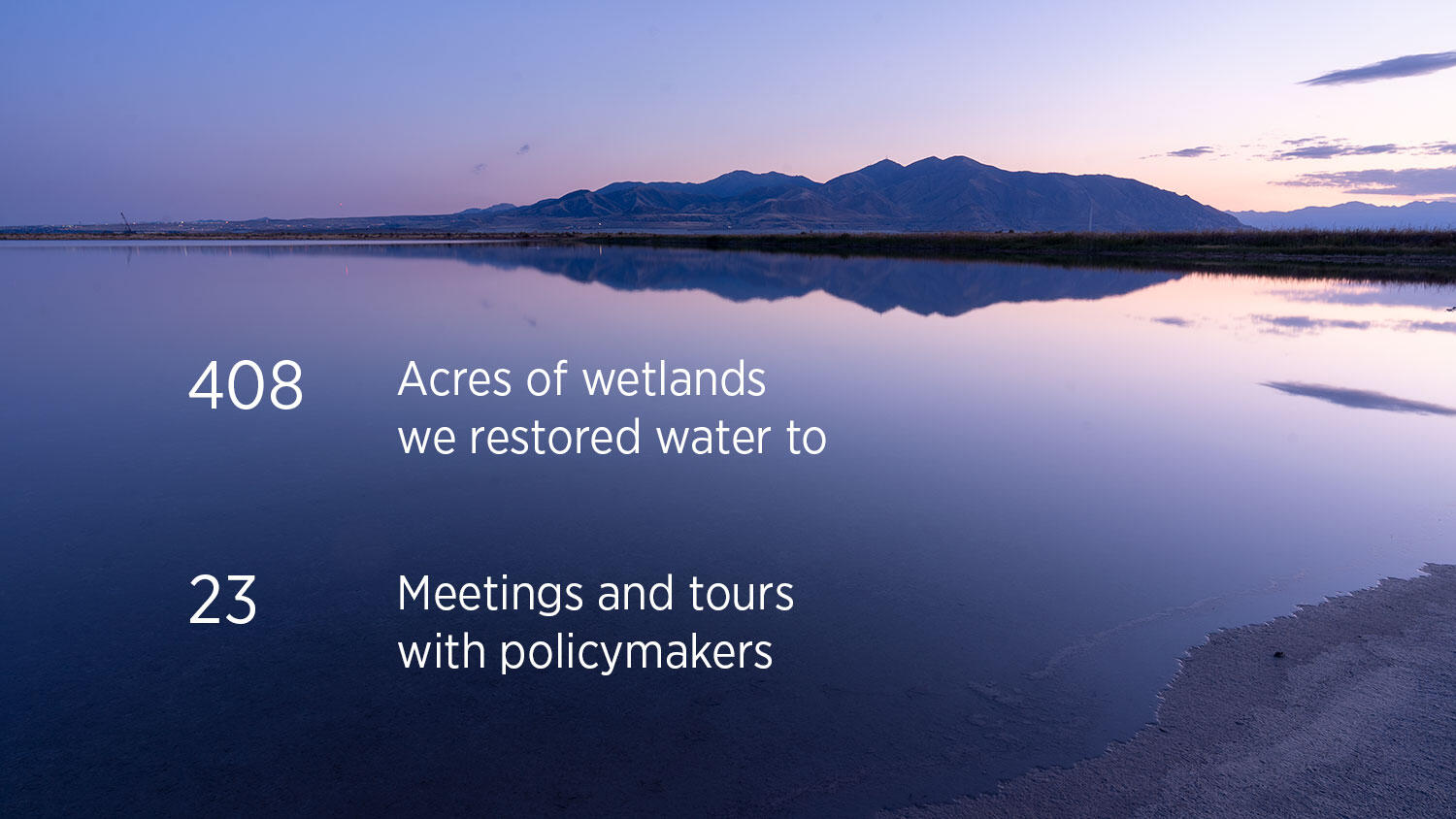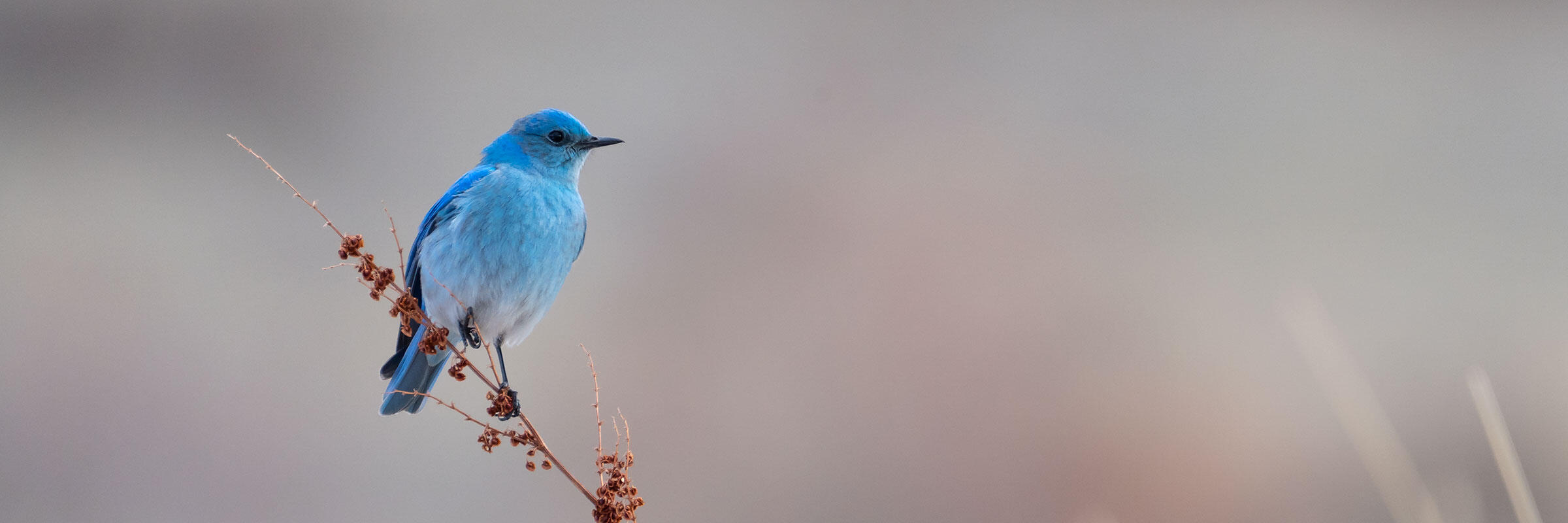Providing research and guidance on the conservation of our most valuable resource
Marbled Godwit. Photo: Tim Timmis/Audubon Photography Awards
Water is the lifeblood of the West. Birds, habitats, people, and economies all depend upon healthy rivers, streams, and wetlands. Up to 80 percent of western wildlife species depend on them for at least part of their life cycles. Saline wetlands along Great Salt Lake alone sustain millions of birds. Colorado’s rivers support critical habitat for hundreds of species of birds and contribute billions of dollars every year to the state’s economy.
But western water is an increasingly scarce resource. Rising demand, a changing climate, and inflexible management are putting western waters at risk. Through our Western Rivers Initiative and wetland management at Gillmor Sanctuary, Audubon Rockies is finding collaborative, science-backed solutions to balance the needs of birds and people in an increasingly dry West.
Everyone needs healthy rivers. Amid a hotter and drier West, our goals are to increase river flows for the benefit of people and wildlife, enhance the health of our watersheds, and restore riverside habit. The Colorado Water Plan was created to guide Colorado towards a more secure water future. Audubon was closely involved in the creation of the plan and currently is involved in its implementation. Now, five years later, we’re helping the state update the plan.
The economic challenges brought on by the coronavirus resulted in a $3.5 billion budget shortfall for the Colorado state government in 2020, creating a major setback to funding the Colorado Water Plan. Fortunately, we can help Colorado’s economy recover by investing in rivers. Water-based recreation generates $18.8 billion annually and supports more than 131,000 jobs. Rivers also provide essential irrigation for agriculture, which contributes $41 billion to the Colorado economy annually and employs nearly 173,000 people, according to the United States Department of Agriculture.
Despite the economic challenges, we continued to advocate for funding Colorado’s Water Plan and advise the state on its implementation. We consulted the Colorado Water Conservation Board and each of the nine Colorado Basin Roundtables. We collaborated with experts and produced a document advising the Colorado Water Conservation Board on environmental considerations of a water demand management program. We provided information to the Colorado Water Conservation Board and the basin roundtables on river health assessments and headwater restoration environmental projects. Finally, we produced a video to inform decision-makers on the importance of funding river restoration.
The year 2020 is a big one for Colorado water. We saw the update of the Colorado Water Plan, the beginning of the renegotiation around the Colorado River, and the performance of the Colorado River drought contingency plans. Due to the importance of these events, we hosted a water education breakfast at the State Capitol for legislators and their staff. At the event, we informed them of the value of Colorado’s water to people and the environment as well as the near- and long-term issues that we will need their action on.
“Even in these dire economic times, funding for Colorado’s Water Plan must be a priority. When we understand the connections—where our water comes from and how much we depend upon it—then we value water for what it is: life and prosperity,” said Western Rivers Regional Program Manager Abby Burk.
After a multi-year, multi-stakeholder effort from Audubon, partners, and other stakeholders to expand Colorado’s existing instream flow program to loan water to the environment, House Bill 20-1157 was signed into law by Governor Jared Polis with wide bipartisan support last March.
Since 1973, Colorado’s instream flow program has given the Colorado Water Conservation Board the unique ability to hold instream flow rights. These are water rights with the sole purpose of preserving or improving the natural environment by remaining in streams or lakes.
House Bill 20-1157 expands the instream flow loan program by increasing the years of participation from three to five in a ten-year period and allows for two additional ten-year renewal periods. According to Burk, “The new bill provides a completely voluntary, flexible, and responsive option for water users to divert less or no water during dry years, allowing for more water to stay in a river, ultimately benefiting our environment, wildlife, and local economies.”
Audubon used its broad network of volunteer bird advocates to support the bill. More than 1,450 Audubon members sent letters to their legislators in support of it. Additionally, Audubon staff participated in and facilitated stakeholder outreach meetings, worked with partners and bill sponsors to draft and review language, and provided testimony to both the Colorado House of Representatives and Senate.
As demand for water increases and supply decreases, the legal ability to keep water in rivers is extremely important. “With increasingly variable and diminishing water supplies, we need expanded and flexible tools for supporting rivers and water users,” said Burk. “While there is more work to be done for the future of the Colorado River and key tributaries in our state, this is a major step forward for the health of our rivers, as well as for the people, birds, economies and communities of Colorado.”

On the shore of Great Salt Lake, Audubon’s 3,184-acre Gillmor Sanctuary provides habitat to huge numbers of shorebirds and other species that rely on the sanctuary’s wetland and upland habitat. Every year millions of shorebirds representing 42 species congregate in the area. For many species, such as Marbled Godwit, Snowy Plover, American Avocet, Black-necked Stilt, Wilson’s Phalarope, and Red-necked Phalarope, Great Salt Lake provides critical nesting or migrating habitat for a large percent of the world’s population.
Amid rapid population growth, protecting Great Salt Lake and its globally important wetlands is more important than ever. Audubon’s goal at Gillmor Sanctuary is to provide diverse and healthy habitats for birds with a focus on managing saline mudflats as shorebird habitat.
This year, sanctuary managers Ella Sorensen and Heidi Hoven co-authored with John Neill, of the Great Salt Lake Ecosystem Program, a chapter titled “Great Salt Lake Shorebirds, Their Habitats and Food” in a new definitive reference book, Great Salt Lake Biology: A Terminal Lake in a Time of Change.
According to book editor Dr. Bonnie Baxter, director of the Great Salt Lake Institute and chair of the biology department at Westminster College, “This is literally the very first review of Great Salt Lake’s shorebirds and is critical because of the timing. The trajectory of the lake elevation is down. The chapter describes through the lens of shorebirds the perilous and urgent situation for Great Salt Lake. This ecosystem faces not only increased water diversions and habitat destruction but also the desiccating effects of climate change, and the authors have put this front and center in their writing."
To write this chapter, the authors created an account for each species that has occurred on Great Salt Lake detailing status, abundance, and timing of arrival and departure. The chapter also discusses the habitats and food available to shorebirds and how these are driven by changes in lake level and salinity, which are intrinsic to a saline lake ecosystem.
The authors hope that the information included in this chapter will dispel some of the misinformation on shorebirds, fill many information gaps in management practices, and promote a greater understanding and appreciation of shorebirds and their habitats. In doing so, we strive towards a better conservation ethic for the millions of shorebirds dependent on a healthy Great Salt Lake for survival.


Mountain Bluebird. Photo: Evan Barrientos/Audubon Rockies
Learn how we're advancing solutions and mitigating impacts of an existential threat.